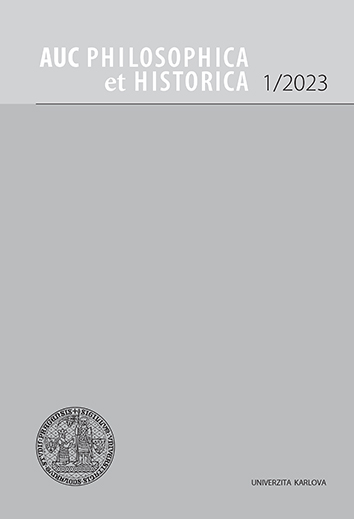AUC Philosophica et Historica (Acta Universitatis Carolinae Philosophica et Historica) is a multidisciplinary academic journal focused on the humanities with more than 50 years of tradition.
The journal is indexed in CEEOL, DOAJ, and EBSCO.
AUC PHILOSOPHICA ET HISTORICA, Vol 2022 No 2 (2022), 9–22
Princip závazku a konzistence chování
[The Principle of Commitment and Consistency of Behavior]
Alexandra Menting
DOI: https://doi.org/10.14712/24647055.2025.8
published online: 12. 08. 2025
abstract
This article’s focus is on the application of the principle of commitment and consistency, which speaks of the fact that the moment we make a commitment, we increase the likelihood that we will maintain consistent behaviour in the matter to which we have committed ourselves. An experimental study on the principle of commitment and consistency of behaviour examines the effect of signing an informed consent containing an instruction not to cheat on the consistency of behaviour – that is, whether an individual will truly not cheat – under the influence of normative social influence. Based on the data obtained, a medium to strong and statistically significant relationship was found between commitment and behaviour. It has been found that half of the participants, when having made a commitment, maintain consistent behaviour even when conditions directly encourage them to be inconsistent. The results show that this is an effective principle of persuasion that works automatically and without us even realising it.
keywords: behavioural economics; persuasion; commitment; consistency of behaviour
references (34)
1. Allgeier, A. R., Byrne, D., Brooks, B., & Revnes, D. (1979). The waffle phenomenon: Negative evaluations of those who shift attitudinally. Journal of Applied Social Psychology, 9, 170-182. CrossRef
2. Asch, S. E. (1946). Forming impressions of personality. The Journal of Abnormal and Social Psychology, 41(3), 258-290. CrossRef
3. Baker, M. (2016). 1,500 scientists lift the lid on reproducibility. Nature, 553, 452-454. CrossRef
4. Becker, H. (1960). Notes on the concept of commitment. American Journal of Sociology, 66, 32-40. CrossRef
5. Borodaeva, Z., Chipeeva, N., Maslennikova, E., Feklicheva, I., Soldatova, E., Esipenko, E., Sharafieva, K., Ismatullina, V., Malykh, S., & Kovas, Y. (2018). Stem gender gap and intra-individual strengths in maths and Russian language. European Proceedings of Social and Behavioural Sciences, 55, 133-144. CrossRef
6. Buchanan, T. (1985). Commitment and leisure behavior: A theoretical perspective. Leisure Sciences, 7(4), 401-420. CrossRef
7. Camerer, C. F. (2020). Introduction. In A. Samson (Ed.), The Behavioral Economics Guide 2020 (pp. VII-XV). https://www.behavioraleconomics.com/be-guide/the-behavioral-economics-guide-2020/
8. Cialdini, R. B., Cacioppo, J. T., Bassett, R., & Miller, J. A. (1978). Low-ball procedure for producing compliance: Commitment then cost. Journal of Personality and Social Psychology, 36(5), 463-476. CrossRef
9. Cialdini, R. B. (2007). Influence: Science and practice (Rev. ed.). Harper Business.
10. Cialdini, R. B. (2016). Před-svědčování. Jan Melvil Publishing.
11. Crandall, C. S., & Sherman, J. (2016). On the scientific superiority of conceptual replications for scientific progress. Journal of Experimental Social Psychology, 66, 93-99. CrossRef
12. Crosby, L., & Taylor, J. (1983). Psychological commitment and its effects on post-decision evaluation and preference stability among voters. The Journal of Consumer Research, 9(4), 413-431. CrossRef
13. Deutsch, M., & Gerard, H. B. (1955). A study of normative and informational social influences upon individual judgment. The Journal of Abnormal and Social Psychology, 51(3), 629-636. CrossRef
14. Disman, M. (2002). Jak se vyrábí sociologická znalost. Karolinum.
15. Dunfield, K. A., & Kuhlmeier, V. A. (2010). Intention-mediated selective helping in infancy. Psychological Science, 21(4), 523-527. CrossRef
16. Freedman, J. L. (1965). Long-term behavioral effects of cognitive dissonance. Journal of Experimental Social Psychology, 1(2), 145-155. CrossRef
17. Freedman, J. L., & Fraser, S. C. (1966). Compliance without pressure: The foot-in-the-door technique. Journal of Personality and Social Psychology, 4(2), 195-202. CrossRef
18. Gahwiler, P., & Havitz, M. E. (1998). Toward a relational understanding of leisure social worlds, involvement, psychological commitment, and behavioral loyalty. Leisure Sciences, 20, 1-23. CrossRef
19. Gálik, S. (2012). Psychologie přesvědčování. Grada.
20. Gerard, H. B. (1968). Basic features of commitment. In R. P. Abelson, E. Aronson, W. McGuire, T. Newcomb, M. Rosenberg, & P. Tannenbaum (Eds.), Theories of cognitive consistency: A sourcebook (pp. 456-463). Rand McNally.
21. Iyengar, S. S., & Lepper, M. R. (2000). When choice is demotivating: Can one desire too much of a good thing? Journal of Personality and Social Psychology, 79(6), 995-1006. CrossRef
22. Kahneman, D. (2012). Myšlení: rychlé a pomalé. Jan Melvil Publishing.
23. Knox, R. E., & Inkster, J. A. (1968). Postdecision dissonance at post time. Journal of Personality and Social Psychology, 8(4, Pt. 1), 319-323. CrossRef
24. Milgram, S. (1963). Behavioral study of obedience. Journal of Abnormal and Social Psychology, 67(4), 371-378. CrossRef
25. Nosek, B. A., & Errington, T. M. (2017). Making sense of replications. eLife, 6. CrossRef
26. Regan, D. T., & Kilduff, M. (1988). Optimism about elections: Dissonance reduction at the ballot box. Political Psychology, 9(1), 101-107. CrossRef
27. Romero, F. (2019). Philosophy of science and the replicability crisis. Philosophy Compass, 14(11), e12633. CrossRef
28. Schmidt, S. (2009). Shall we really do it again? The powerful concept of replication is neglected in the social sciences. Review of General Psychology, 13, 90-100. CrossRef
29. Shoemaker, D., Snizek, W., & Bryant, C. (1977). Toward a further clarification of Becker's side-bet hypothesis as applied to organizational and occupational commitment. Social Forces, 56(2), 598-603. CrossRef
30. Simon, H. A. (1957). Models of man, social and rational: Mathematical essays on rational human behavior in a social setting. Wiley.
31. Stanovich, K., & West, R. (2000). Individual differences in reasoning: Implications for the rationality debate. The Behavioral and Brain Sciences, 23, 645-665. CrossRef
32. Tversky, A., & Kahneman, D. (1974). Judgment under uncertainty: Heuristics and biases. Science, 185(4157), 1124-1131. CrossRef
33. Whitley, B. E., Jr., Nelson, A. B., & Jones, C. J. (1999). Academic cheating in early childhood: Role of age, gender, personality, and self-efficacy. Sex Roles: A Journal of Research, 41(9-10), 657-680. CrossRef
34. Zaltman, G., & Wallendorf, M. (1983). Consumer behavior: Basic findings and management implications. Wiley & Sons.

Princip závazku a konzistence chování is licensed under a Creative Commons Attribution 4.0 International License.
